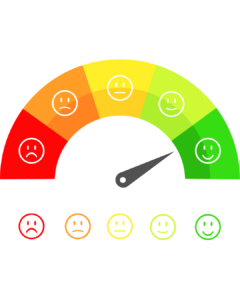Customer Health Score
A customer health score is a metric that helps businesses evaluate their customers’ overall health and satisfaction. It typically takes into account a range of factors, such as customer engagement, behavior, usage patterns, and feedback.

A customer health score aims to provide a holistic view of the customer relationship, highlighting areas of strength and areas for improvement. This can help businesses identify customers at risk of churning and those likely to become loyal advocates.
A customer health score is the outcome of a variety of methods, including surveys, usage data analysis, and machine learning algorithms. Common metrics used to calculate customer health scores include customer retention, satisfaction, product usage, and lifetime value.
By monitoring and improving their customer health score, businesses can build stronger relationships with their customers, increase retention rates, and ultimately drive growth and revenue.
Formula
The formula for calculating a customer health score can vary depending on the business and the specific factors. Here is an example of a basic formula that takes into account customer satisfaction, engagement, and retention:
Customer Health Score = (Customer Satisfaction Score * Engagement Score * Retention Score) ^ (1/3)
In this formula, the Customer Satisfaction Score, Engagement Score, and Retention Score are each given a weight based on their importance to the business.
The individual scores can be calculated as follows:
- Customer Satisfaction Score: This shows surveys, Net Promoter Score (NPS), or other feedback mechanisms. The score can range from 0 to 10, with 10 indicating the highest level of satisfaction.
- Engagement Score: This can be measured by tracking customer interactions with the business, such as website visits, email opens, or app usage. The score can be a percentage of the total available interactions.
- Retention Score: This measures the customer churn rate or the percentage of customers who have discontinued their relationship with the business over a certain period of time.
Once the individual scores are calculated and weighted, they can be multiplied together and then raised to 1/3 power to arrive at the final Customer Health Score. This score can track changes in customer health over time and identify areas for improvement.
Importance of Customer Health Score in SaaS
The customer health score is particularly important in SaaS (Software as a Service) businesses for several reasons:
- Subscription-based business model: SaaS businesses typically operate on a subscription-based business model, where customers pay a monthly or yearly fee for access to the software. Therefore, customer retention is critical to the success of the business. The customer health score helps SaaS businesses track customer engagement and identify opportunities to improve retention rates.
- Highly competitive market: The SaaS market is highly competitive, with numerous providers offering similar products and services. A high customer health score can give SaaS businesses a competitive advantage by indicating that they are effectively meeting customer needs and building strong, long-lasting relationships with customers.
- Real-time insights: The customer health score provides real-time insights into customer engagement and satisfaction, allowing SaaS businesses to identify and address customer needs and issues quickly. This can help companies to improve customer satisfaction, reduce churn, and drive growth and revenue.
- Data-driven decision-making: SaaS businesses rely heavily on data to inform product development, marketing strategies, and customer engagement initiatives. The customer health score provides valuable customer engagement, satisfaction, and retention data, allowing businesses to make data-driven decisions that can improve the customer experience and drive business growth.
Overall, the customer health score is a critical metric for SaaS businesses that can help drive customer engagement, retention, and growth. By monitoring and improving the customer health score, SaaS businesses can build strong, long-lasting relationships with customers and thrive in a highly competitive market.
How to Increase Customer Health Score?

There are several strategies that businesses can implement to increase their customer health score:
- Improve customer satisfaction: Customers who are satisfied with a business are more likely to remain loyal and continue to engage with the company. To improve customer satisfaction, businesses can collect and act on customer feedback, provide excellent customer service, and regularly communicate with customers.
- Increase engagement: Customers engaged with a business are likelier to become loyal advocates. Companies can personalize communication, offer promotions or incentives, and provide relevant and valuable content to increase engagement.
- Focus on retention: Retaining customers is critical to increasing the customer health score. Businesses can reduce churn rates by providing a seamless user experience, responding to customer feedback, and offering excellent customer service.
- Monitor usage patterns: By tracking usage patterns, businesses can identify areas where customers may need additional support or education. This information proactively addresses customer needs and improves their product or service experience.
- Offer upsell and cross-sell opportunities: Customers with high health scores are more likely to be receptive to additional products or services. By offering to upsell and cross-sell opportunities, businesses can increase customer lifetime value and improve the overall health score.
- Use customer data to inform decision-making: By analyzing customer data, businesses can identify trends and patterns that can inform product development, marketing strategies, and customer engagement initiatives. This can help enterprises to meet customer needs better and improve the overall health score.
Overall, improving the customer health score requires a customer-centric approach focusing on building strong, long-lasting customer relationships. By prioritizing customer satisfaction, engagement, retention, and data-driven decision-making, businesses can increase the health score and drive growth and revenue over the long term.
Drawbacks
While the customer health score can be a valuable metric for businesses, there are also some potential drawbacks to consider:
- Complexity: Developing an effective customer health score can be complex and time-consuming. The score must take into account a wide range of factors. This includes customer satisfaction, engagement, retention rates, and lifetime value. Developing a score that accurately reflects these factors can be challenging.
- Subjectivity: The customer health score may be subjective, depending on the specific factors and the methods used to calculate the score. Different teams or individuals within a business may have different opinions on what factors to include in the score and how they should be weighted.
- Incomplete data: The customer health score is only as good as the data on its basis. If the data is incomplete or inaccurate, the score may not accurately reflect the health of the customer relationship. For example, if a business does not have complete data on a customer’s engagement or satisfaction levels, it may not be easy to assess their health score accurately.
- Risk of misinterpretation: The customer health score may not be adequately understood. For example, a high customer health score may not necessarily indicate that a customer is delighted with the business or that they are likely to remain a customer in the long term. Therefore, it is essential to consider the customer health score in conjunction with other metrics and data to get a complete picture of the customer relationship.

Overall, while the customer health score can be a valuable metric for businesses, it is essential to be aware of these potential drawbacks and to use the score in conjunction with other metrics and data to get a complete picture of the customer relationship.
Customer Health Score: Companies Examples
Many companies use customer health scores to measure and monitor the health of their customer relationships. Here are a few examples:
- Salesforce: Salesforce is a leading customer relationship management (CRM) software provider. The company uses a customer health score to track customer engagement and identify opportunities for improvement. The score is high on factors such as customer satisfaction, product usage, and renewal likelihood.
- HubSpot: HubSpot is a marketing and sales software platform. The company uses a customer health score to monitor customer engagement and retention. The score is high based on factors such as product usage, support interactions, and account health.
- Intercom: Intercom is a customer messaging platform. The company uses a customer health score to measure customer engagement and identify opportunities to improve the customer experience. The score focuses on product usage, customer feedback, and support interactions.
- Adobe: Adobe is a leading provider of software for creative professionals. The company uses a customer health score to monitor customer engagement and identify opportunities for improvement. The score highlights factors such as product usage, customer feedback, and renewal likelihood.
- Atlassian: Atlassian is a provider of software for software development teams. The company uses a customer health score to measure customer engagement and retention. The score focuses on factors such as product usage, support interactions, and account health.

Overall, many companies across a wide range of industries use customer health scores to measure and monitor the health of their customer relationships.
Quantitative Aspects of Customer Health Score
The quantitative aspects of customer health scores typically involve measuring specific metrics related to customer engagement, satisfaction, and product usage. Here are some standard quantitative metrics that calculate customer health scores:
- Net Promoter Score (NPS): NPS measures the likelihood of a customer recommending your product or service to others. It is an outcome of subtracting the percentage of detractors (customers who would not recommend your product) from the percentage of promoters (customers who would recommend your product).
- Customer satisfaction score (CSAT): CSAT measures customers’ satisfaction with your product or service. It measures through a survey that asks customers to rate their satisfaction on a scale of 1-10.
- Product usage: Measuring product usage can provide insight into customers’ engagement with your product or service. This can include metrics such as time spent using the product, frequency of use, and feature usage.
- Customer churn rate: The churn rate measures the percentage of customers who have stopped using your product or service. A high churn rate can indicate issues with customer satisfaction or engagement.
- Customer lifetime value (CLV): CLV measures the total value a customer brings to your business over the course of their relationship with you. This can include metrics such as purchase history, frequency of purchases, and referral activity.

By tracking and measuring these metrics, you can gain insight into your customer relationships’ health and identify improvement areas. In addition, these quantitative metrics can be combined with qualitative feedback from customers to create a more holistic view of customer health.
Components of Customer Health Scorecard
The components of a customer health scorecard may vary depending on the business and its objectives, but generally, it includes the following components:
- Customer Metrics: The scorecard should include metrics that are relevant to the business and the customer journey. These metrics can be both quantitative (e.g., Net Promoter Score, customer satisfaction score, churn rate, etc.) and qualitative (e.g., customer feedback, support interactions, etc.).
- Scoring System: The scorecard should have a scoring system that assigns a numerical value to each metric. This value can calculate an overall customer health score. The scoring system can be a simple rating scale or a more complex algorithm that takes into account multiple metrics and their relative importance.
- Weighting: Different metrics have different levels of importance to a business. Therefore, weighing each metric differently, depending on its preference, is essential. For instance, the customer churn rate may have a higher weight compared to customer feedback.
- Thresholds: Thresholds categorizes customers according to their health score. A customer’s score falls within specific ranges that indicate whether they are healthy or at risk. These thresholds help the business identify the customers needing attention and provide a framework to manage customers with different health scores.
- Action Plan: An action plan is essential to a customer health scorecard. It outlines the actions that customers should take in different health score ranges. For instance, if a customer is at risk, the action plan may include a proactive customer outreach strategy to address any issues and improve their satisfaction.
By incorporating these components, businesses can gain a better understanding of the overall health of their customer base and take action to address any issues proactively. This can help improve customer satisfaction and retention, leading to better business outcomes.
Why Should Businesses Measure Customer Health Scores?
Businesses should measure customer health scores for several reasons:
- Predictive Indicator of Customer Satisfaction: A customer health score is a predictive indicator of customer satisfaction. By tracking customer health scores over time, businesses can identify patterns and trends that help them predict the likelihood of customer churn.
- Proactive Management of Customer Relationships: A customer health score enables businesses to manage their customer relationships proactively. By identifying customers who are at risk or require attention, companies can prioritize their resources and take the necessary actions to prevent churn and improve customer satisfaction.
- Business Performance: A customer health score provides a framework for measuring business performance. By tracking customer health scores over time, businesses can evaluate the effectiveness of their customer engagement and retention strategies.
- Alignment of Business Objectives: A customer health score helps align business objectives with customer objectives. By measuring customer health scores, businesses can understand how their products and services meet customer needs and identify areas for improvement.
- Competitive Advantage: A customer health score can give businesses a competitive advantage. By proactively identifying areas for improvement and addressing customer needs, companies can differentiate themselves from their competitors and improve customer retention and loyalty.
In summary, measuring customer health scores can help businesses understand their customers better. They can manage their relationships proactively, and improve business performance, resulting in better customer retention and loyalty.






